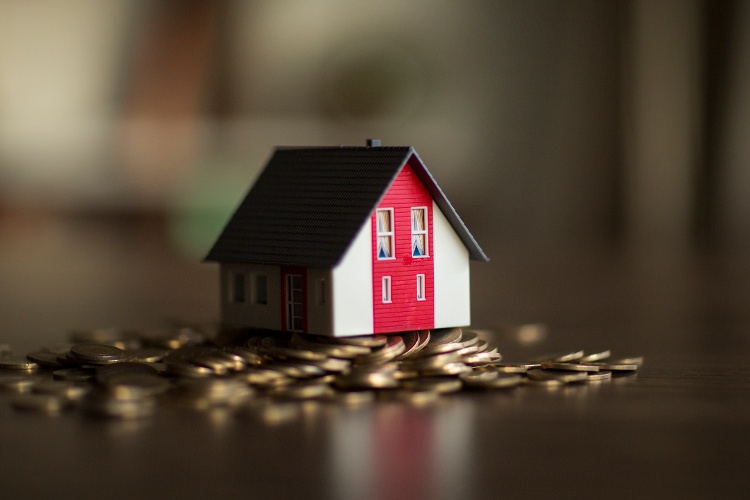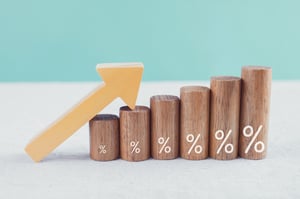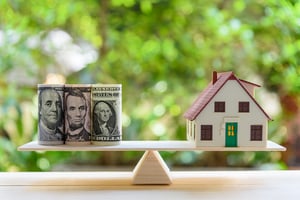Beginning real estate investors sometimes believe that the higher the cap rate, the better the deal is. But that isn’t necessarily the case.
In this article, we’ll look at why cap rates matter and what they really mean, why a higher cap rate isn’t always better, and the best ways to find cap rates for residential rental property.
What is a Real Estate Cap Rate?
A real estate cap rate, or capitalization rate, is a measurement of the rate of return you are receiving from your income property.
The cap rate formula is used when making an apples-to-apples comparison of similar income-producing properties in the same real estate market. Unlike the gross rent multiplier (GRM) formula that doesn’t factor in operating expenses, or cash-on-cash return which can easily be “juiced” or increased by putting less money down, cap rate return is the same for every investor.
To calculate cap rate:
- Add up the gross income (including rents plus additional income flows) of the property
- Subtract routine property operating expenses (excluding debt service, capital reserve allocations, and depreciation)
- Divide this number (which is also your NOI or net operating income) by the market value or the price you plan on paying for the property
Cap rate formula:
- Cap rate = NOI / Market value
- Gross rent = $15,000 minus $5,000 operating expenses = $10,000 net operating income
- $10,000 NOI / $100,000 Market value = .10 x 100 = 10% Cap rate

Why Cap Rates are Important
Rental property investors calculate cap rates for three important reasons:
1. Measure the current and expected performance of similar properties in the same real estate market, to determine which has the highest rate of return:- Property A: $7,000 NOI / $80,000 Market value = 8.75% Cap rate
- Property B: $9,000 NOI / $95,000 Market value = 9.47% Cap rate
- Property C: $12,000 NOI / $150,000 Market value = 8% Cap rate
- Market value = NOI / Cap rate
- $8,000 NOI / .06 or 6% Cap rate = $133,333 Market value
- NOI = Market value x Cap rate
- $150,000 Market value x .08 or 8% Cap rate = $12,000 NOI
Is a Higher Cap Rate Always Better?
Before you can determine if a cap rate is high (or low) you need to know what the “normal” cap rate is for similar property in the same market you are investing in.
Commercial real estate and investment firm CBRE publishes a semi-annual North American Cap Rate Survey. The firm’s Second Half 2019 report found these cap rate ranges for different classes of investment real estate in the U.S.:
- Office: 7.8% to 6.65%
- Industrial: 6.13%
- Retail: 9.98% to 7.47%
- Hotels: 8.55% to 7.99%
- Multifamily: 5.37% to 5.11%
Investment property most affected by an economic downturn, such as retail and hotels, have higher cap rates because property prices are dropping.
On the other hand, residential property such as multifamily apartments is less affected by a recession. In fact, prices may actually be rising, depending on the local real estate market.

What a High Cap Rate Really Shows
Investors use cap rates to determine fair market value, potential rate of return, and to select real estate markets where the returns are greatest.
At first glance, it might seem that the higher the cap rate the better. While that might be true, it’s important to understand what a high cap rate could really mean:
1. Annual rate of return: Cap rates provide a “snapshot” of annual returns, but the cap rate calculation does not tell you how an income property has historically performed, or how it will perform financially over a multi-year holding period.For example, you may be looking at an income property with a 6% cap rate when comparable properties have cap rates of 8%. As you conduct your pre-offer due diligence, you discover that due to bad management rents are below market. If you purchase the property and hire a new property manager, over a short period of time you could increase your cap rate simply by raising the rent:
- Before rent increase: $6,000 NOI (with rents below market) / $100,000 market value = 6%
- After rent increase: $8,000 NOI (with rents at market) / $100,000 = 8%
Of course, the opposite situation could also be true.
Let’s say one day you come across a rental property for sale with a cap rate of 15% in a market where you know the going cap rates are 8%. Upon further investigation, you learn that the seller was using the house as a short-term vacation rental where the income is naturally higher.
The seller’s cap rate is absolutely correct based on current NOI. However, due to the current economic situation, the property won’t attract above-market vacation rental rates for the foreseeable future.
When you rent to a long-term tenant, you will have to charge fair market rent, causing the cap rate to decline as well. After crunching the numbers, you decide to pass on the deal and invest in a turnkey rental property rented to a long-term tenant instead.
2. Future rent growth : Cap rates are usually the highest in Class C “cash cow” rental property. This type of investment generates consistently strong cash flows but does not significantly appreciate in market value, if at all. Because of the nature of the neighborhood and tenant demographics, updating or making value adds won’t result in an increase in rents.
This means that if you invest in an income property with a 10% cap rate this year, your cap rate will probably be the same year after year and the property value will remain unchanged. On the other hand, investing in a house with a lower cap rate could mean there’s more room for raising the rent each year, which in turn increases the market value of your investment.
3. Risk vs. reward: You can also use cap rates to measure the balance of risk and reward. This is similar to the way bonds work.
For example, Treasury Bills currently have rates of close to 0% because they are backed by the full faith and credit of the U.S. Government and are viewed as the ultimate “risk free” investment. On the other hand, Triple-C-rated high yield bonds – also known as junk bonds - currently return just over 14% because the risk of default and non-payment is much greater.
Cap rates, or the rate of return, also vary based on the class of real estate you invest in. Neighborhood rating is one way to separate rental property by class. By going to the investment property marketplace on Roofstock we typically find:
- Class A: neighborhood rating of 5, cap rates 4% to 5%
- Class B: neighborhood rating of 3-4, cap rates 6% to 7%
- Class C: neighborhood rating of 0.5 – 2.5, cap rates 8% or higher

Other Ways to Analyze Income Property
The cap rate calculation is an important tool to use when analyzing income-producing property.
However, cap rates do not take into account the power of leverage and how a rental property is financed. Also, a current cap rate isn’t as useful for value-add investors purchasing Class B rental property to rehab and reposition, because the current income is much less than what the future income should be.
Additional ways of analyzing real estate include:
Cash-on-cash return
Takes into account the power of leverage by comparing the annual cash returned to the initial cash invested:
- Cash-on-cash return = Annual cash returned / Amount of cash invested
- $5,000 Annual cash / $25,000 Down payment cash invested = .20 or 20% cash-on-cash return
When you are buying an income property, be wary of a seller who claims the property has high cash on cash return.
Sometimes, sellers or their brokers will “juice” the cash on cash by using a riskier lower down payment. In the example above, by reducing the down payment to $15,000 the property cash-on-cash return would be over 33%.
Debt coverage ratio (DCR)
DCR measures the ability to cover the annual mortgage payments from the annual net operating income the property is generating. As with the cap rate, the NOI used for the DCR calculation does not include the debt service:
- DCR = NOI / Mortgage payment
- $10,000 NOI / $7,500 Mortgage payment = 1.33 DCR
The closer the DCR is to 1.0 the less income there is from the property to pay for the mortgage. In general, most banks will not make a loan if the DCR is below 1.25.
Gross rent multiplier (GRM)
GRM is a ratio that compares the property price to the gross annual rent. Similar to the cap rate calculation, GRM is most useful for comparing similar properties to one another:
- GRM = Property price / Gross annual rent
- $100,000 Property price / $15,000 Gross annual rent = 6.67
While GRM is an easy calculation to make, it overlooks important factors such as vacancy allowance, operating expenses, and potential deferred maintenance.
Wrapping Up
Depending on your investment strategy, a high cap rate could be fantastic, just average, or something you may decide to take a pass on:
- Cap rate measures the annual rate of return for income-producing property
- Cap rate calculation is good for comparing similar properties in the same real estate market
- Leverage and debt service are not taken into consideration when calculating the cap rate
- High cap rates may indicate rents are below market, or that future rent growth will be low
- Class C rental property usually has the highest cap rate due to large amounts of cash flow









